
(May 2019; updated November 2019)
I wrote what follows because I feel the urgency to do everything possible to avoid what a number of scientists believe to be one of the world’s greatest environmental disasters.
The unprecedented environmental disaster in question is known as Llurimagua, a large-scale copper mining project. The site where the Ecuadorian government and CODELCO, the Chilean state mining company, intend to impose mining is where communities have been resisting the opening of the copper mine for 25 years. In addition to relocating communities, there is no doubt that the mine will destroy one of the world’s most biologically diverse forests, habitat for many species in danger of extinction, in addition to polluting rivers for millennia.
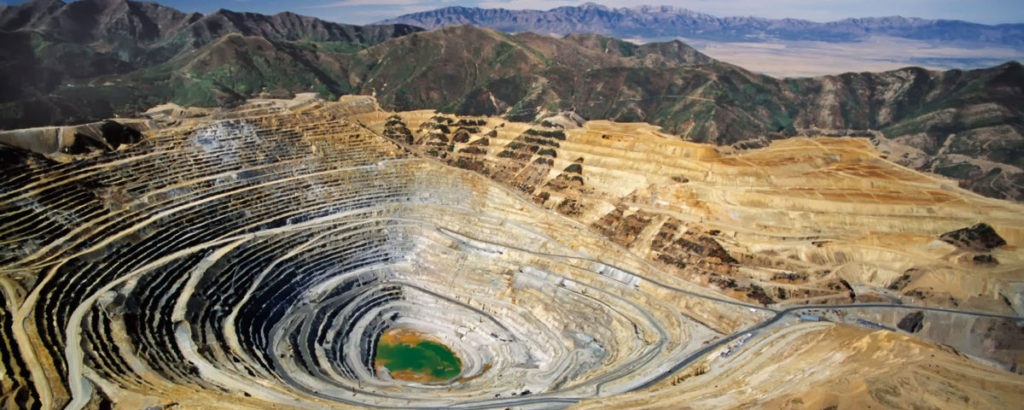
DECOIN has been actively working with communities since 1995 to stop large-scale mining development in Ecuador’s northwestern region. We are a grass-roots environmental organization, whose members live and work in the area we are trying to protect. For our work to keep Intag free of large-scale mines, plus our creative and very effective conservation work, which includes the creation of 38 community-owned forest and watershed reserves, the United Nations awarded us the prestigious 2017 Equator Prize. These community-owned reserves are conserving close to 13,000 hectares of forests and endangered species, and the protected watersheds are providing clean water to thousands of Intag’s residents.
Our most pressing work is, after all these years, stopping a large-scale mining project which threatens to devastate primary forests and pristine watersheds, which harbor over 200 species facing extinction, and at least two that live here and nowhere else in the world.
Besides outright buying forests for communities and local governments, our work also includes biological research (see section below on frogs); legal remedies (we currently are working on a Constitutional Injunction), environmental education at all levels, including high school and elementary kids; supporting sustainable activities, such as ecological tourism. For more details, please contact us at decooin@gmail.com.
Mining
It is extremely difficult for most persons to envision the social and environmental impacts a large-scale metal mining project would generate in Ecuador’s diverse and biodiverse ecosystems. Most of you have never seen what an open-pit mine looks like, nor heard of the lasting effects of acid mine drainage. Even fewer will know that it takes, on average, over a ton of ore to produce one gram of gold, and that large mining companies can extract, crush and process hundreds of thousands tons of mineralized subsoil (ore) per day. Very few will have learned about the forced displacement of communities, or the hundreds of conflicts, gross human rights abuses and violence these mines generate. Nor will you likely know that it takes millions of gallons of water and a toxic brew of chemicals to extract the grams of gold or pounds of copper and other minerals that one ton of ore may hold.
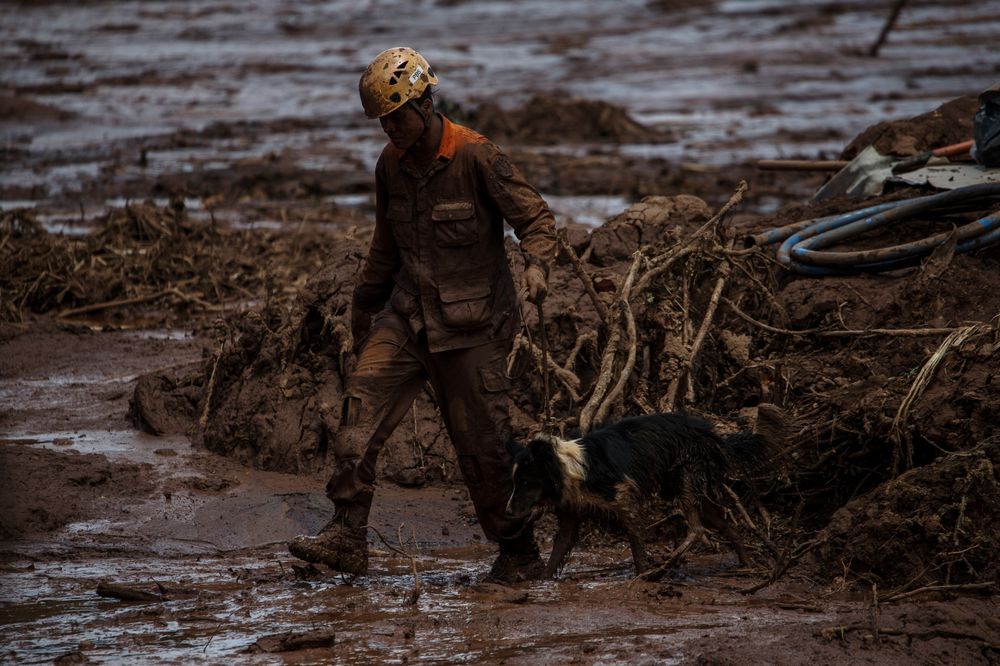
Mining is damaging enough in deserts and semi-arid places where much copper comes from, but it is much more socially and environmentally destructive in places like Ecuador for the reasons listed below.
Most of the impacts you will read about below are largely based on a technical report commissioned by the Japan International Cooperation Agency for a small open-pit copper mine in the biodiverse Toisan Range, in Northwest Ecuador. The Study was done by the Japan Minerals and Mining Agency. Unlike most Environmental Impact Assessments (EIAs), which are paid for and often edited by mining companies, this preliminary EIA was financed by Japanese public funds; consequently, it is the only study done for a mining project in Ecuador which presents a more realistic picture of the impacts generated by a large-scale open pit mine in the country’s ecosystems.
IMPACTS
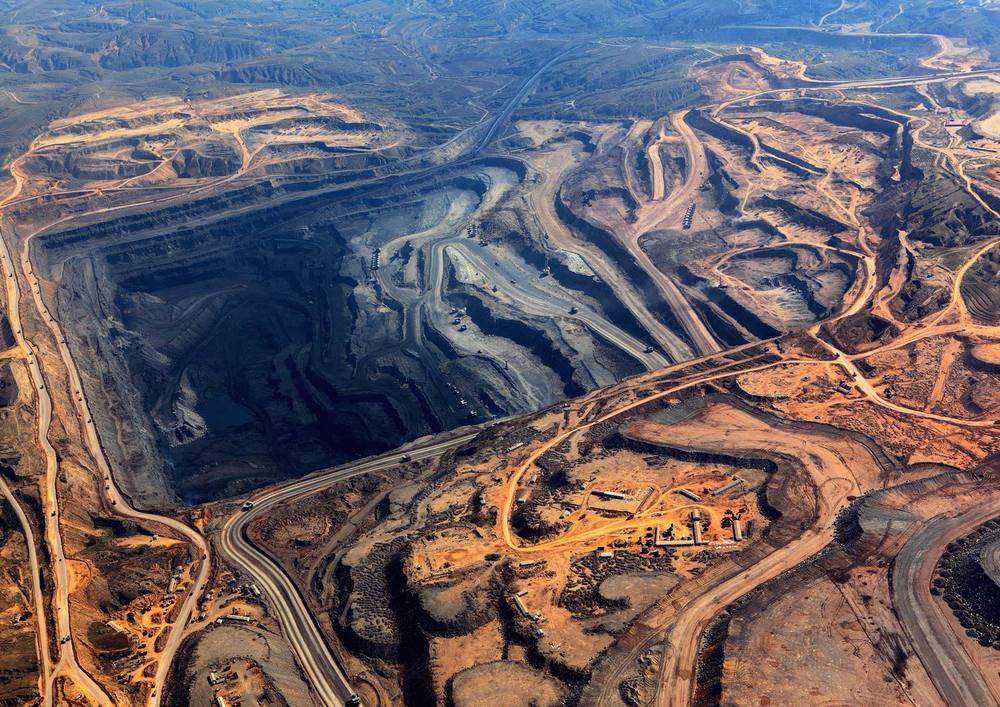
A. The impacts described below are based on a proposed 72 million-ton ore deposit containing 0.7% copper, 0.003% molybdenum, plus arsenic, lead, cadmium, chrome, and other toxic substances (equivalent to 450,000 tons pure copper). A year after this study was completed, the Japanese exploring the site inferred the existence of an ore deposit five times larger. Subsequently, in April 2019, unofficial estimates reported in the press an ore deposit 50 times larger. If these estimates are true, the impacts described below will be multiplied many, many times over.
- Relocation of communities. Unlike mining districts in Chile’s Atacama Desert or those in the arid regions of Australia and the U.S. Southwest, the Intag region, where the copper mining project is located, is extremely biodiverse. There are also dozens of small, rural communities and hundreds of landowners within the mining concessions. It is also especially rich in rivers and streams. According to the Japanese EIA, the mining project would relocate hundreds of families from four communities. Subsequently, the Japanese found five times more copper, which will increase the number of communities affected. Relocation of communities almost invariably leads to human rights abuses, and often leaves the relocated community residents in worse living conditions, financially and socially, than those they experienced prior to moving. (The much larger April 2019 estimates imply the relocation of several more communities).
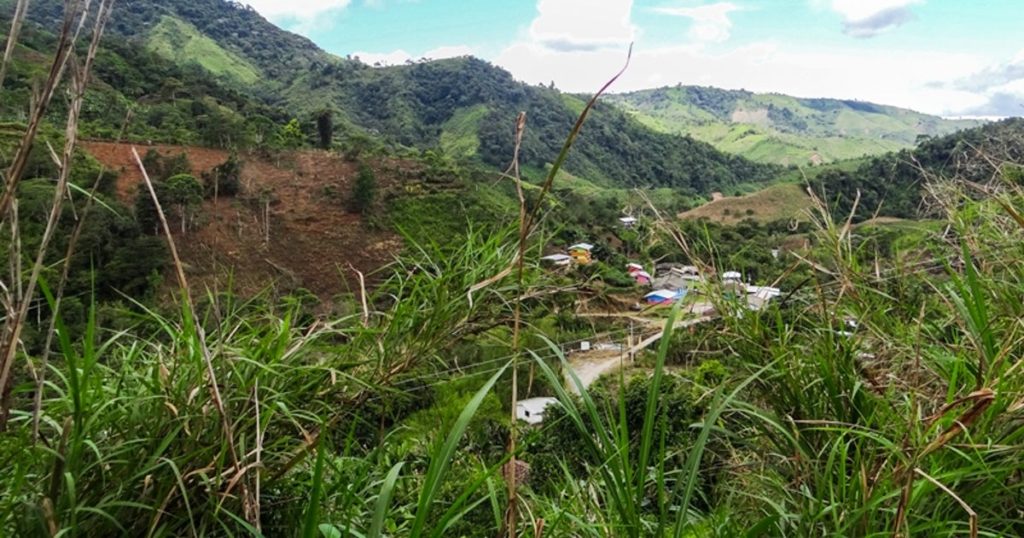
2. The proposed mining project would impact primary cloud forests. What’s so special about cloud forests? Less than 2.5% of the world’s tropical forests are cloud forests. They are not only exceptionally biologically diverse – as well as severely threatened – but play an outsize role in protecting headwater watersheds, thus preventing silting and downstream flooding. Millions of Ecuadorians depend on protected watersheds for their daily water needs.
3. The project would cause massive deforestation (in the words of the experts preparing the EIA). The small mine would directly impact 4,025 hectares directly.
4. Deforestation, according to the Japanese, would lead to severely diminished precipitation – the scientists who wrote the impact study use the word desertification, affecting thousands of small farm families.
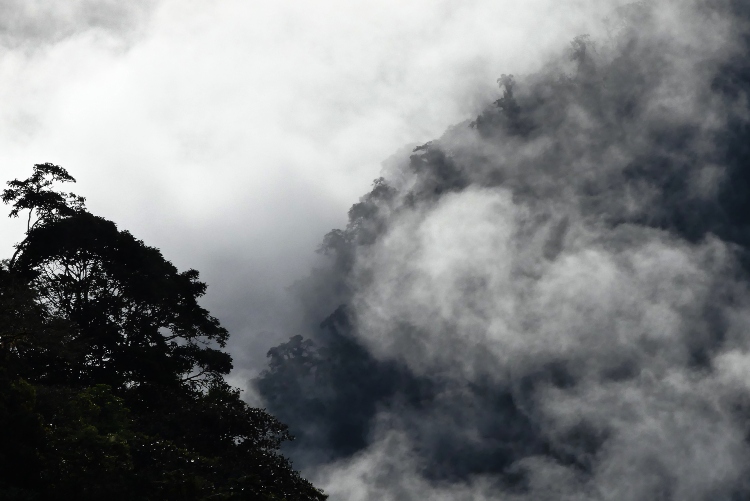
5. Intag’s forests belong to the world’s top Biodiversity Hotspot, the Tropical Andes. A Biodiversity Hotspot is an area with a high rate of biodiversity with many endemic species (located only there) in danger of extinction. The scientists who produced the study in 1996 identified 12 species of mammals and birds facing extinction that would be impacted by the project, including jaguars, spectacled bears, mountain tapirs, and the brown-faced spider monkey. Based on a 2017 in depth study by biologist Bitty Roy and others, eight critically endangered species, 37 endangered species, 153 vulnerable, 89 near threatened, as well as numerous other less threatened species were identified within Intag and adjacent forests (https://bit.ly/2ORqcvV). The list includes two critically endangered primates (Brown-Headed Spider Monkey and White-Fronted Capuchin). Another species of note was the Longnose Harlequin Frog, which was considered extinct until it was recently discovered within the Llurimagua mining concession owned by CODELCO, the Chilean state’s mining company.
UPDATE, January 2019
As of this writing (April 7, 2019) Codelco is in the process, through its Ecuadorian state mining partner, ENAMI, of asking permission from the Ecuadorian government to expand its exploratory activities an additional 701 hectares. This new forest is no less biodiverse than the previous forest Codelco and Enami trashed. In fact, biologists investigating the new site reported finding two critically endangered species: the Brown-faced Spider Monkey and Lynch’s Giant Glass Frog. If government approval is granted, the expansion will impact primary and secondary cloud forests, several other animals facing extinction, and will also impact an important archaeological site (based on information taken from the Environmental Impact Study), not to mention dozens of primary micro watersheds and the Junin River.
Two Extinct Species Rediscovered
On March 2016, biologist from the JAMBATO CENTER reported finding the Longnose Harlequin Frog (Atelopus longirostris) in a forest threatened by the mining project (http://bit.ly/2x7fFlV). Previously, it was listed as extinct on the IUCN Red List.
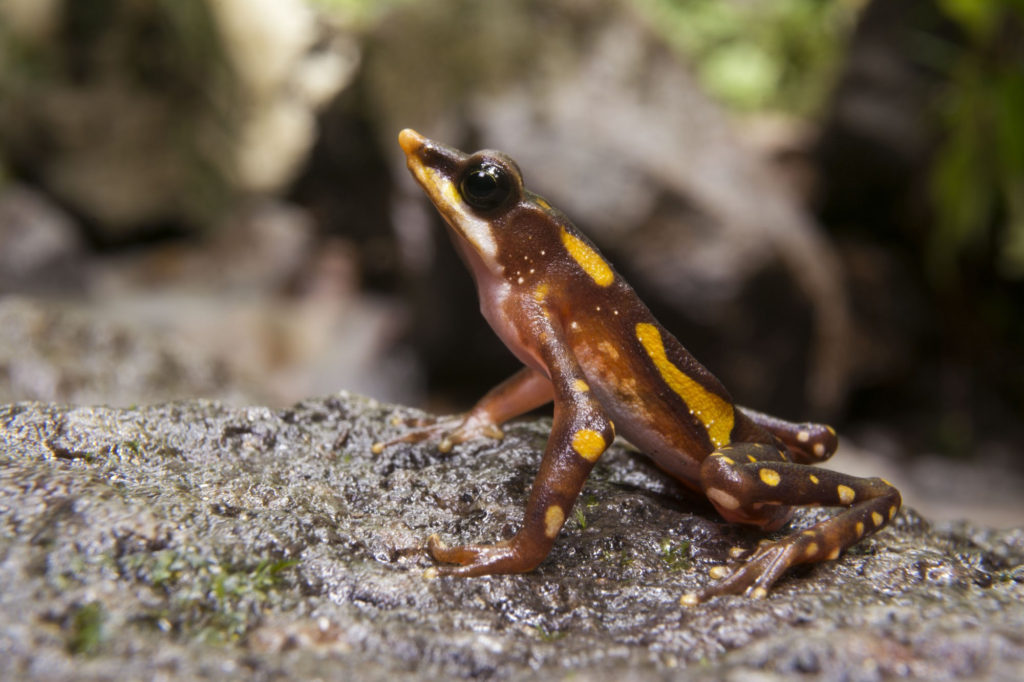
As important as this finding is, on Septemeber of 2019, the same foundation discovered an even rarer frog; the Confusing Rocke Frog (Ectopoglossus confusus). The frog was also considered extinct until the recent finding (the finding is so recent that it has not been reported officially). This forest now constitutes the only place on Earth where these critically endangered species survive in the wild. In addition, the area has several other endemic species, such as the recently discovered Shape-shifting Frog (Pristimantis mutabilis), and the Black-breasted Puffleg Hummingbird, which exists in only two patches of high altitude cloud forests, one of which is located in Intag. But this is only the tip of the iceberg.
6. There are dozens of pristine rivers and streams within the concession; not an uncommon phenomenon in the Andes. The EIA predicted they would be contaminated with lead, arsenic, chromium, cadmium, and other toxic substances, in some cases, to more than 10,000% over natural levels.
7. The study identified several pre-Incan archeological sites within the mining area. Mining would, unquestionably, destroy these national treasures. (The most recent on data on this subject are from 2018.)
8. The 1996 study also highlighted the fact that it would impact the Cotacachi-Capayas Ecological Reserve (one of the world’s most biologically diverse protected areas and the only one of any significant size in all of western Ecuador).
Besides these very serious impacts identified in the Study (for a mine a fraction of what it could very likely end up being) there are other significant problems with mining in areas like Intag.
B. Legal hassles
9. Large-scale mining would violate local laws, such as the legally-binding Cotacachi County Ecological Ordinance created in 2000. Only the Constitutional Tribunal can rule on the validity of the Ordinance in light of the new Constitution. And the Tribunal has not.
In addition, at the beginning of 2019, UNESCO declared the province of Imbabura (in which Intag is located) a Global Geopark, the first in Ecuador. Geoparks are areas where conservation, education, and tourism are supposed to be priority activities.
10. Ecuador’s new Constitution demands that communities be consulted before any project impacting their social or natural environment takes place. This constitutional guarantee has been disregarded from the first day the government tried, violently, to impose the mining project in Intag in 2014. The Constitution also grants nature rights, and the people the right to Sumak Kawsay, or a Good Life (also translatable as Harmonious Life). Up to now, Ecuador’s central government administrations have not respected the Constitution or other laws intended to protect communities and the natural environment in Intag. Will a future administration? Only time will tell.
A Damning Investigation
In March of 2019, the nation’s Comptroller General released the results of a year-long investigation into the Llurimagua mining project (https://bit.ly/2TDvQSX). The report meticulously detailed grievous violations of laws, regulations and the environmental license which, according to the author of the report, should have led to the suspension of the project. The information contained in the 84-page report lends itself to present several lawsuits to stop the mining projects. It ratifies, without any doubt, just how impossible it is to do responsible mining in Ecuador.
Political Scenario.
11. One of the things the government likes to emphasize is that it has the area´s political support. In March 2019, five of Intag’s six parish governments elected presidents affiliated with the political party opposed to mining, including in the Parish where the Llurimagua mining project is located. These local governments are joining hands with civil society to reject mining in Intag. Moreover, in 2017, the County government approved a Resolution calling for metal mining to halt within all of its territory, including Intag, and in 2018, a county-wide Ordinance was passed declaring all of Intag an ACUS, that is, Area for Conservation and Sustainable Use. In addition, the mining threat, which now affect all of Intag due to the granting of additional concessions, has mobilized people and organizations on the national level.
C. Opposition.
There is widespread opposition to the Intag mining project. This includes:
12. Community Opposition. Most communities surrounding the mining project are still, after all these years, opposed to the project. Twenty-four years of resistance has honed their skill in resisting (the right to resist is now protected by the Constitution). In fact, in November 2013, scientists hired by the government to carry out an environmental impact study were stopped by the communities, in spite of heavy police and military presence in the area. It was only after the illegal arrest of the president of JUNIN in April 2014 (details below), and after storming the mining concessions with hundreds of Swat-type police units a month later, that the company was able to enter the mining concessions.
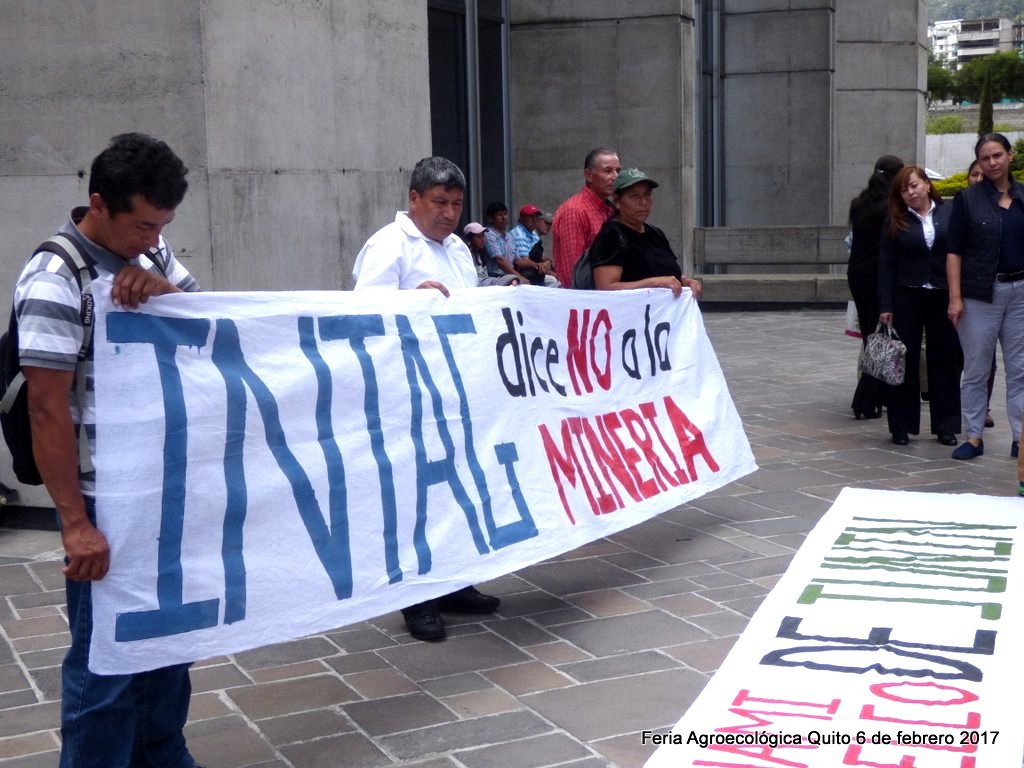
13. Human Rights
Human rights abuses are a phenomenon in most mining districts in the Andes and elsewhere. After years of stopping dozens of attempts by government and private companies to access the mining concession, which overlaps communal land, in order to carry out the environmental impact study and begin exploration, Ecuador’s government and Chilean-owned Codelco only succeeded in doing research in May of 2014 and then only with the help of hundreds of police who terrorized the area for two months and violated rights, such as the right to freely circulate. To intensify the intimidation, a month earlier Javier Ramírez, president of the Junín community, was arrested and jailed under highly irregular circumstances, which have been denounced by human rights organizations such as Amnesty International and The International Human Rights Federation, as well as several national human rights groups. Javier was released after being sentenced in February of 2015 but only after serving 10 months in jail. His brother, Victor Hugo, remains in hiding, accused of sabotage, the same criminal offense leveled against his brother, for putting up resistance to the presence of mining employees in their territory.
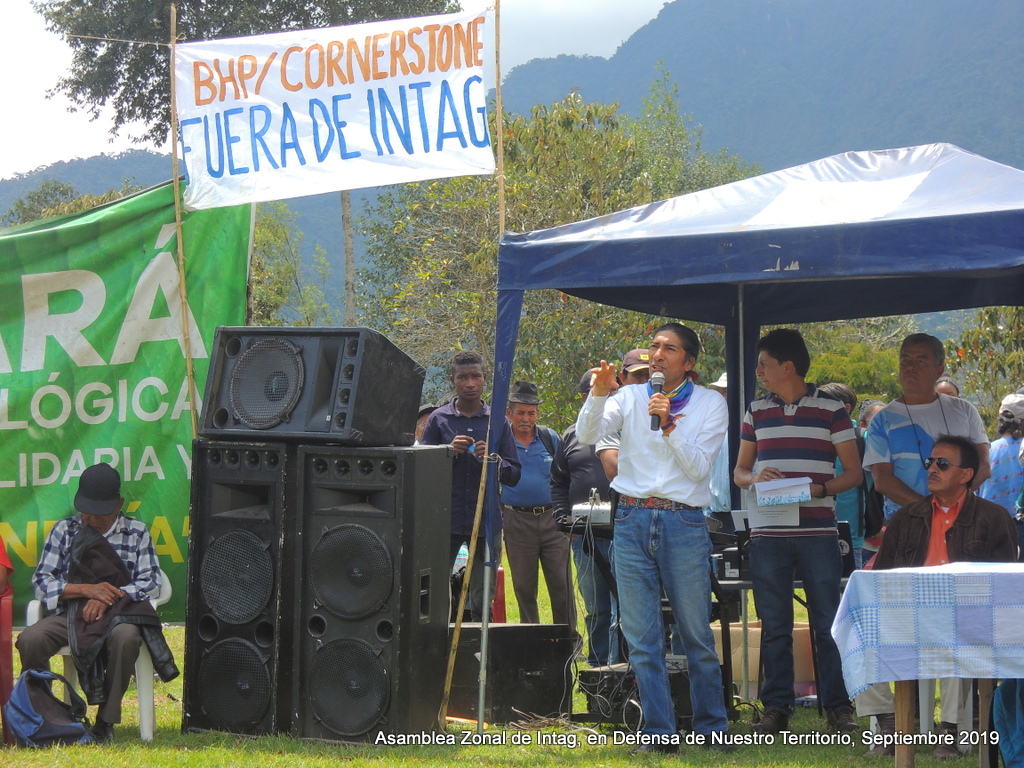
14. As is true for the rest of Ecuador, local organizations oppose mining once they find out its real impact. In the Intag region, 90% of NGOs oppose the project. In late 2012, the most important civil society organizations in Intag wrote a letter to Chile’s president to make sure he understood that the organizations would again rise to defend the area if Codelco or anyone went tried to revive the project. More recently, in June of 2019, dozens of organizations signed a Manifesto rejecting mining . And only three months later, nearly 1,500 Intag residents met in a regional Assembly, soundly rejecting mining and giving the companies 60 days to pack un and leave. Furthermore, just two months later, in the town of Peñaherrera, over 1200 representatives from all of Cotacachi County likewise took the decision to reject mining in Intag and Cotacachi in the annual assembly, held since 1996. Resolutions taken at the Assembly, by law, have to be implemented by local governments.
D. Exaggerated Claims
15. It is common for companies to exaggerate the resources they hold in their mining concessions, in order to raise capital with investment firms or on stock exchanges. The Junin project is no different. In 2007, for example, Micon International, the entity contracted by Ascendant Copper to evaluate the Junin copper deposit, said that it could not confirm their earlier estimates due to degradation of samples. Copper Mesa claimed that the Junin copper deposit had four times more copper than what the Japanese inferred after years of exploration. In all, 2.26 million tons were inferred by the Japanese, which is a little less than 1/10th of what the world consumes annually (and it would take decades to mine it all). Regarding more recent information (2018) various estimates have been floated, from 3,900 million tons of ore to the 2.26 million tons the Japanese originally inferred, to the aforementioned 3.8 billion tons reported by the press in March of 2019. Wild numbers usually indicate the presence of speculators. In any case, the deposit has not gone beyond an inferred or indicated status, making for a lot of uncertainty regarding the viability of the project (the most reliable category is measured, which Codelco has not arrived at yet)).
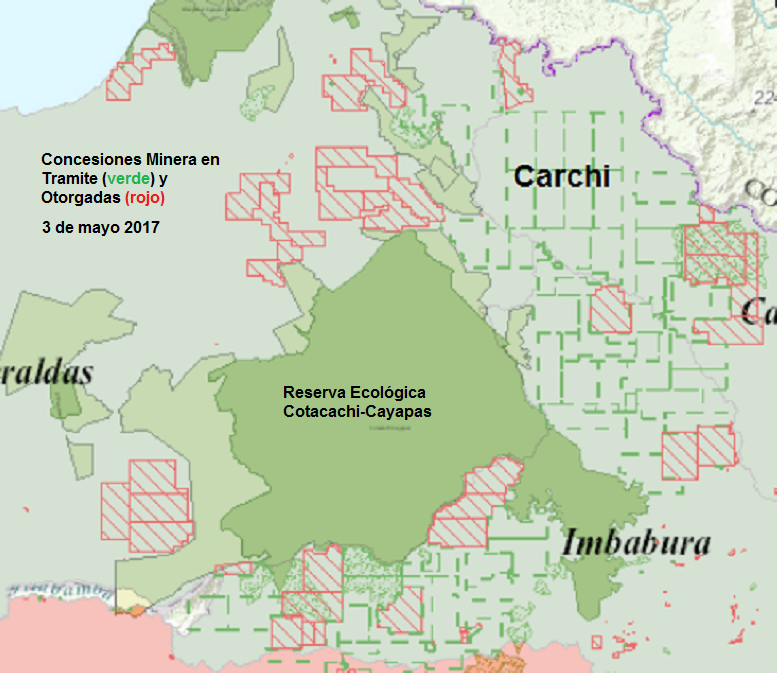
E. Further environmental challenges
16. Most of Ecuador’s mining concessions are situated in mountainous regions, like the Toisan Range, the site of the Intag copper concession. This area gets between 3000 and 4000 millimeters of annual rainfall (120 to 150 inches). Heavy rainfall, together with abundant underground aquifers and heavy metals in the ore make for a deadly mix. Not only that, but they raise the price of mining considerably, while greatly increasing the risks of man-made disasters, such as landslides. For an idea of what a landslide can do in an open pit mine, go here:
17. Acid Mine Drainage is a chemical phenomenon almost impossible to control. It happens when sulfur compounds in mining ore and waste rock come into contact with air and water. The sulfur acidifies the water, which then leaches heavy metals from used-up ores, plus the equally contaminated subsoil lying between the ground level and the ore. Once started, it may take thousands of years for the acidity to be neutralized. Most ores in South America have sulfur compounds mixed in with the gold, copper, and other metals sought by companies.
18. In sites like that of the proposed Junin mine, there is a superabundance of underground water (according to the Japanese EIA). This is bad news for mining companies and even worse news for the environment. In order to open large pits to dig out the ore, streams and aquifers must be diverted or dried up so the mine-pit does not fill up with water. If the water is pumped from inside the pit, as will be inevitable given the high rainfall and seepage, the water will likely be contaminated with heavy metals as a result of Acid Mine Drainage.
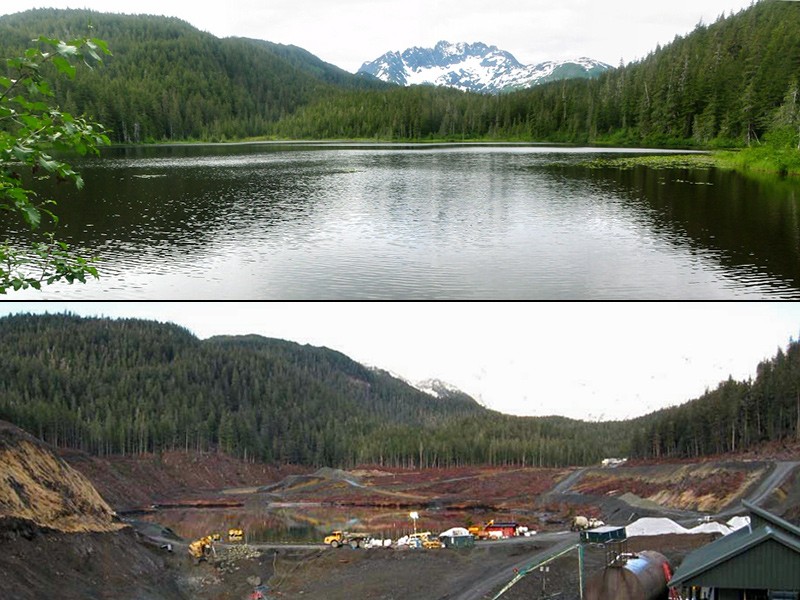
19. The area where they found the copper is exceptionally steep and mountainous, making mining much more difficult and expensive than most mines (the latest Environmental Impact Statement for the expansion of exploratory activities, made public on January 2019, highlights this risk).
20. Based on the Japanese study, there are clear indications that Junín’s copper is very deep, making mining much more environmentally destructive and economically risky.
21. The Toisan Range, and the Andes in general, have many geological faults, posing significant earthquake risks. In fact, the 2019 EIA, classifies the area as being located in an area substantially at risk of a major earthquake within 10 years.
22 and 23. The 2019 discovery of the two endemic frogs (see above) that will, without a doubt, become extinct if mining is permitted. An issue ripe for the equivalent of the Supreme Court to decide if it violates the Constitutional Righst of Nature.
There are, in fact, many more than 23 reasons for mining not to be allowed in areas like Intag. But these should suffice for any company, or investor, who considers himself or herself responsible. Any responsible company must accept that there are certain sites that are, and should remain, no-go sites. This is one of them.
In the end, if companies like Codelco go ahead with mining in areas like Intag, the mines will go down in history as being some of the world’s greatest environmental disasters. We must act to make sure this doesn’t happen.
Compiled by Carlos Zorrilla
Defensa y Conservación Ecológica de Intag
DECOIN Winner of the 2017 United Nations Equator Initiative Prize for Conservation
toisan06@gmail.com decointag@gmail.com
** Videos about Intag’s Struggle
Further Reading
Basic background on mining impacts https://en.wikipedia.org/wiki/Environmental_impact_of_mining
More detailed information: https://www.elaw.org/files/mining-eia-guidebook/Chapter1.pdf
